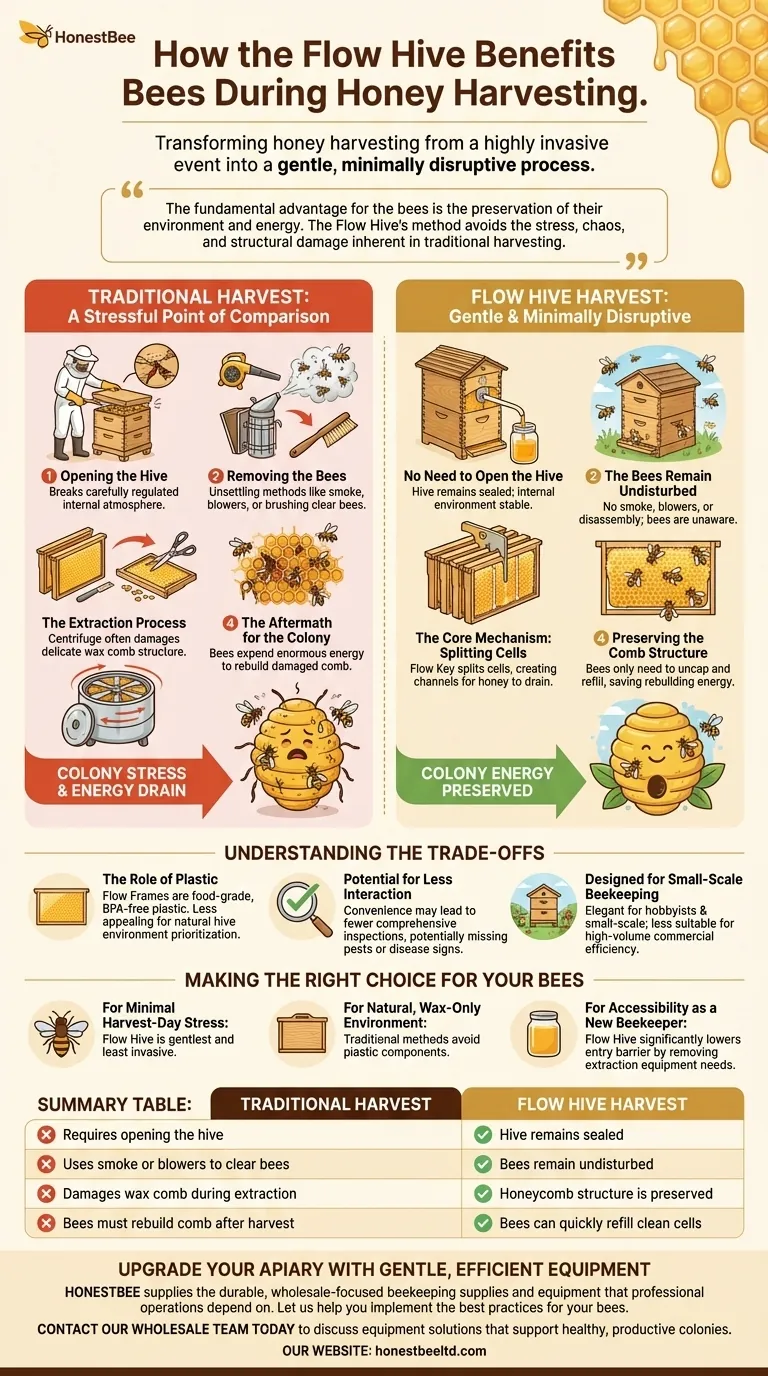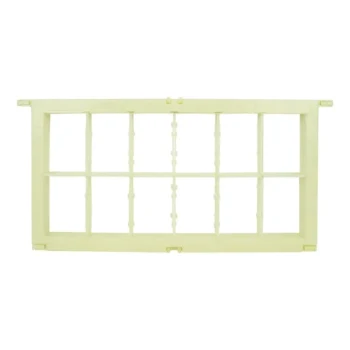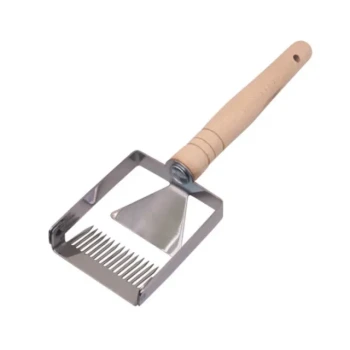At its core, the Flow Hive benefits bees by transforming honey harvesting from a highly invasive event into a gentle and minimally disruptive process. Instead of opening the hive, using smoke, and forcibly removing bees, the Flow Hive allows a beekeeper to drain honey directly from the frames while the colony remains largely undisturbed inside.
The fundamental advantage for the bees is the preservation of their environment and energy. The Flow Hive's method avoids the stress, chaos, and structural damage inherent in traditional harvesting, allowing the colony to continue its work without the significant setback of rebuilding its home.

The Traditional Harvest: A Stressful Point of Comparison
To understand the benefit of the Flow Hive, one must first appreciate the disruptive nature of conventional honey harvesting.
Opening the Hive
Traditional harvesting requires the beekeeper to physically break the propolis seal and open the hive box. This act alone breaks the colony's carefully regulated internal atmosphere.
Removing the Bees
Beekeepers must clear the bees from the honey frames before extraction. This is typically done with unsettling methods like blasts of smoke, leaf blowers, or by physically brushing the bees off the comb.
The Extraction Process
Once the frames are removed, the wax cappings are cut off. The frames are then placed in a centrifuge (an extractor) that spins at high speed to force the honey out, often damaging the delicate wax comb structure in the process.
The Aftermath for the Colony
After a traditional harvest, the bees must expend enormous energy and resources to repair or completely rebuild the damaged honeycomb before they can begin storing honey again.
How the Flow Hive Changes the Process
The Flow Hive was designed specifically to eliminate these stressful and destructive steps, fundamentally changing the interaction between beekeeper and bee during harvest.
The Core Mechanism: Splitting Cells
Flow Frames are made of a pre-formed plastic honeycomb foundation. The bees complete these cells with their own wax and fill them with honey. When a special "Flow Key" is inserted and turned, it splits the cells vertically, creating channels for the honey to flow down and out of the hive.
No Need to Open the Hive
Because the honey flows directly out of the hive through a tube and into a jar, the hive itself remains sealed. The bees' home is not physically breached, and their internal environment remains stable.
The Bees Remain Undisturbed
With no smoke, no blowers, and no disassembly of their home, the bees are often unaware that a harvest is even taking place. They can continue their normal functions like foraging, tending to the queen, and guarding the hive.
Preserving the Comb Structure
After the honey is drained, the beekeeper turns the key back, closing the channels. The bees are left with a fully intact comb structure. They only need to uncap the cells, clean them, and refill them, saving the immense energy required to rebuild from scratch.
Understanding the Trade-offs
While the benefits to the bees during harvest are clear, a complete picture requires acknowledging the system's design and its implications.
The Role of Plastic
The Flow Frames are made from food-grade, BPA-free plastic. For some beekeepers who prioritize an all-natural hive environment, the use of any plastic components in the honey super is a significant drawback compared to traditional wood and wax frames.
Potential for Less Interaction
The system's convenience can lead to a more "hands-off" approach. While observation windows are included, the ease of harvesting might tempt new beekeepers to perform fewer comprehensive hive inspections, potentially missing early signs of pests, disease, or other issues.
Designed for Small-Scale Beekeeping
The Flow Hive is an elegant solution for hobbyists, urban beekeepers, and small-scale operations. Its design prioritizes minimal disruption and ease of use over the high-volume efficiency required for large commercial apiaries.
Making the Right Choice for Your Bees
Your decision should be guided by your primary goals as a beekeeper and your personal philosophy on hive management.
- If your primary focus is minimizing harvest-day stress on the colony: The Flow Hive's external draining system is arguably the gentlest and least invasive method available.
- If your primary focus is a natural, wax-only hive environment: You will likely prefer traditional methods that avoid the use of plastic components for honey storage.
- If your primary focus is accessibility as a new or hobbyist beekeeper: The Flow Hive significantly lowers the barrier to entry by removing the need for separate, expensive, and messy extraction equipment.
Ultimately, understanding the core differences in harvesting methodology empowers you to choose the approach that best aligns with the well-being of your colony.
Summary Table:
| Traditional Harvest | Flow Hive Harvest |
|---|---|
| Requires opening the hive | Hive remains sealed |
| Uses smoke or blowers to clear bees | Bees remain undisturbed |
| Damages wax comb during extraction | Honeycomb structure is preserved |
| Bees must rebuild comb after harvest | Bees can quickly refill clean cells |
Upgrade Your Apiary with Gentle, Efficient Equipment
For commercial apiaries and beekeeping equipment distributors, the well-being of your colonies is directly linked to your productivity and honey quality. The principles behind the Flow Hive—minimizing stress and disruption—are key to modern, sustainable beekeeping.
HONESTBEE supplies the durable, wholesale-focused beekeeping supplies and equipment that professional operations depend on. Let us help you implement the best practices for your bees.
Contact our wholesale team today to discuss equipment solutions that support healthy, productive colonies.
Visual Guide

Related Products
- Automatic Honey Flow Beehive 4 Frame Mini Hive for Beekeeping
- Stainless Steel Triangle Support Honey Strainer and Filters
- Mesh Ventilated 3 Layer Goatskin Beekeepers Gloves for Beekeeping
- Professional Sectional Comb Honey Frame with 250g Cassette System for Beekeeping
- HONESTBEE Durable Frame Wiring Board with Integrated Tensioner
People Also Ask
- How does the Flow Hive improve bee health? By Minimizing Stress During Honey Harvest
- What are the benefits of using the Flow Hive for honey harvesting? Simplify Your Harvest & Protect Your Bees
- How does the Flow Hive simplify honey harvesting? The Revolutionary 'Honey on Tap' System Explained
- What is the selling point of the Flow Hive? A Revolutionary, Stress-Free Honey Harvest
- What are the benefits of a Flow Hive? Revolutionize Your Harvest with Ease and Care



















